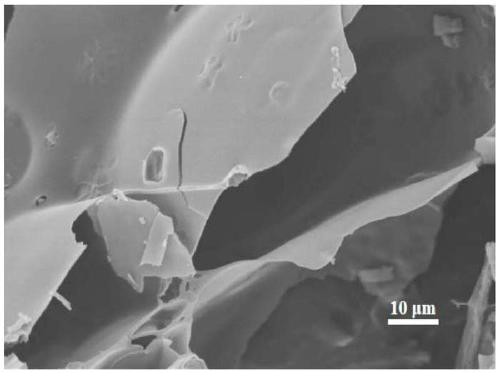Preparation method of nitrogen sulfur co-doped carbon nanosheet material
A technology of nitrogen-sulfur co-doping and carbon nanosheets, which is applied in nano-carbon, electrical components, battery electrodes, etc., can solve problems such as pollution and post-processing difficulties
- Summary
- Abstract
- Description
- Claims
- Application Information
AI Technical Summary
Problems solved by technology
Method used
Image
Examples
Embodiment 1
[0037] Dissolve 1g sodium carboxymethylcellulose in 100mL deionized water, stir magnetically for 6-8h; weigh 10g potassium chloride and dissolve it in sodium carboxymethylcellulose solution, mix the obtained sodium carboxymethylcellulose After the solution was frozen at -12°C for 24 hours, a solid sample was obtained and placed in a -48°C environment for freeze-drying for 48 hours; the dried sample was carbonized in a high-temperature nitrogen atmosphere, the carbonization temperature was 800°C, and the carbonization time was 2 hours The carbonized product is washed 4 to 5 times with deionized water, and vacuum dried at 80° C. for 12 hours to obtain a carbon nanosheet material.
[0038] The SEM test results show that the obtained carbon material has a sheet-like structure with a sheet thickness of 10 to 26 nm, but the XPS test results show that the content of nitrogen and sulfur elements is zero, and the XRD test shows that there is no crystallization peak of inorganic salts.
Embodiment 2
[0040] Dissolve 1g sodium carboxymethylcellulose and 2g thiourea in 100mL deionized water, stir magnetically for 6-8h; weigh 15g potassium chloride, and dissolve it in sodium carboxymethylcellulose solution, the resulting carboxymethyl The sodium cellulose mixed solution was frozen at -12°C for 24 hours to obtain a solid sample, which was freeze-dried in an environment of -48°C for 48 hours; the dried sample was carbonized in a high-temperature nitrogen atmosphere, and the carbonization temperature was 800°C. The carbonization time is 2 hours; the carbonized product is washed with deionized water for 4 to 5 times, and vacuum dried at 80° C. for 12 hours to obtain nitrogen and sulfur co-doped carbon nanosheet materials.
[0041] The SEM test results show that the final carbon material presents a sheet-like structure with a thickness of 5-10nm. At the same time, the SEM element distribution map shows that nitrogen, oxygen and sulfur are evenly distributed in the carbon material; XPS...
Embodiment 3
[0043] Dissolve 1g sodium carboxymethylcellulose and 1g thiourea in 100mL deionized water, stir magnetically for 6-8h; weigh 15g potassium chloride and 1g potassium nitrate, and dissolve them in sodium carboxymethylcellulose solution to obtain The mixed solution of sodium carboxymethyl cellulose was frozen at -12°C for 24h to obtain a solid sample, which was freeze-dried in an environment of -48°C for 48h; the dried sample was carbonized in a high temperature nitrogen atmosphere, and the carbonization temperature The carbonization time is 800°C, and the carbonization time is 2h; the carbonized product is washed with deionized water for 4 to 5 times, and vacuum dried at 80°C for 12 hours to obtain nitrogen and sulfur co-doped carbon nanosheet materials.
[0044] The applicant has verified that the thickness of the carbon nanosheet material co-doped with nitrogen and sulfur is 5-6nm ( figure 1 ), and nitrogen, oxygen and sulfur are evenly distributed in the carbon material ( figure...
PUM
| Property | Measurement | Unit |
|---|---|---|
| particle diameter | aaaaa | aaaaa |
Abstract
Description
Claims
Application Information
 Login to View More
Login to View More - R&D
- Intellectual Property
- Life Sciences
- Materials
- Tech Scout
- Unparalleled Data Quality
- Higher Quality Content
- 60% Fewer Hallucinations
Browse by: Latest US Patents, China's latest patents, Technical Efficacy Thesaurus, Application Domain, Technology Topic, Popular Technical Reports.
© 2025 PatSnap. All rights reserved.Legal|Privacy policy|Modern Slavery Act Transparency Statement|Sitemap|About US| Contact US: help@patsnap.com



